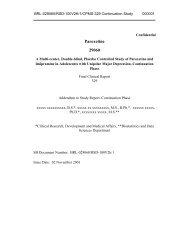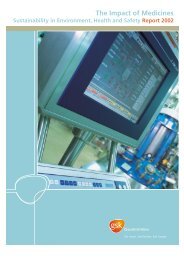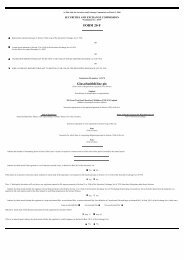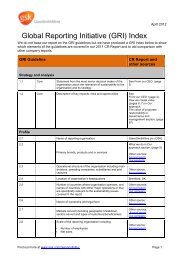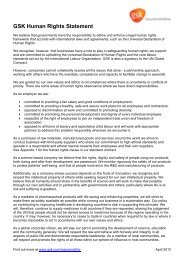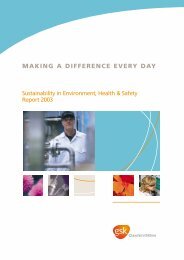GSK Annual Report 2002
GSK Annual Report 2002
GSK Annual Report 2002
You also want an ePaper? Increase the reach of your titles
YUMPU automatically turns print PDFs into web optimized ePapers that Google loves.
33 Employee costs continued<br />
Notes to the financial statements GlaxoSmithKline 115<br />
Throughout <strong>2002</strong> the pension arrangements in some of the former Glaxo Wellcome companies and former SmithKline Beecham companies<br />
continued to be operated separately. However in some instances, including the USA, the pension arrangements have been merged. The<br />
following information deals with each set of arrangements accordingly.<br />
The market value of the assets of the Group’s funded defined benefit pension funds at the dates of the latest actuarial valuations, some<br />
of which date back to 1999, was £6.5 billion and the actuarial value of assets was sufficient to cover approximately 113 per cent of the<br />
benefits that had accrued to members after allowing for future salary and pension increases.<br />
The UK defined benefit pension schemes account for approximately 70 per cent of the Group’s plans in asset valuation and projected<br />
benefit terms and the US defined benefit pension schemes account for approximately 25 per cent of the Group’s plans in asset valuation<br />
and projected benefit terms.<br />
In December <strong>2002</strong>, the Group made special funding contributions to the UK, US and German pension schemes totalling £320 million.<br />
The company will review the pension position annually and will make further contributions as appropriate. Pension costs are expected<br />
to be higher in 2003 than in <strong>2002</strong> as the new actuarial valuations of the UK and US schemes become available.<br />
UK<br />
In the UK the defined benefit pension schemes operated for the benefit of former Glaxo Wellcome employees and former SmithKline<br />
Beecham employees remain separate. These schemes were closed to new entrants in 2001 and subsequent UK employees are entitled to<br />
join a defined contribution scheme. The relevant assumptions used in calculating the pension costs of both the former Glaxo Wellcome<br />
and former SmithKline Beecham UK defined benefit schemes for accounting purposes are as follows:<br />
<strong>2002</strong> 2001<br />
% pa % pa<br />
Rate of increase of future earnings 4.0 4.0<br />
Discount rate 8.0 8.0<br />
Expected long-term rate of return on investments 8.0 8.0<br />
Expected pension increases 2.5 2.5<br />
UK equity dividend growth 5.0 5.0<br />
The regular cost for the Glaxo Wellcome pension arrangements in <strong>2002</strong> was £62 million, which became a £14 million credit for the<br />
financial statements, after allowance was made for spreading the surplus disclosed as a level percentage of salary over the expected<br />
future working lifetime of the existing members (some 11 years).<br />
The most recent triennial actuarial valuations of the Glaxo Wellcome schemes for funding purposes were carried out as at<br />
31st March 2000. At that date the assets of the schemes represented 133 per cent of the actuarial value of all benefits accrued to<br />
members after allowing for future salary and pension increases. The trustees of the UK pension schemes agreed, at the company’s<br />
request, to grant various benefit improvements, which included a five per cent enhancement in the entitlement of all beneficiaries. After<br />
allowance was made for these improvements, the funding level fell to 123 per cent. Following the valuations, normal company<br />
contributions to the schemes remain suspended at least until the next formal valuation. The total market value of the assets held by the<br />
schemes at 31st March 2000 was £3,670 million.<br />
The regular cost for the SmithKline Beecham schemes in <strong>2002</strong> was £17 million, which increased to an accounting cost of £28 million after<br />
allowance was made for the spreading of the deficit over the expected future working lifetime of current employees in the scheme (some<br />
11 years). The latest valuation was carried out at 31st December 1999 and at that date the actuarial value of scheme assets represented<br />
90 per cent of the actuarial value of the accrued service liabilities based on the <strong>2002</strong> assumptions. The total market value of assets held<br />
by the scheme at 31st December 1999 was £1,077 million.<br />
USA<br />
In the USA the former Glaxo Wellcome and SmithKline Beecham defined benefit and hybrid schemes were merged during 2001. The<br />
relevant assumptions used in calculating the pension costs for accounting purposes are as follows:<br />
<strong>2002</strong> 2001<br />
% pa % pa<br />
Rate of increase of future earnings 5.5 5.5<br />
Discount rate 9.5 9.5<br />
Expected long-term rate of return on investments 9.5 9.5<br />
Cash balance credit/conversion rate 6.5 6.5<br />
US equity dividend growth 7.75 7.75<br />
The regular cost for the US scheme in <strong>2002</strong> was £64 million, which increased to an accounting cost of £77 million after allowance was<br />
made for the spreading of the deficit over the expected future working lifetime of current employees in the scheme. The latest valuation<br />
was carried out at 1st January <strong>2002</strong> and at that date the actuarial value of scheme assets represented 90 per cent of the actuarial value<br />
of the accrued service liabilities. The total market value of assets held by the scheme at 1st January <strong>2002</strong> was £1,536 million.








